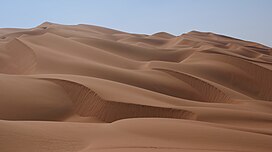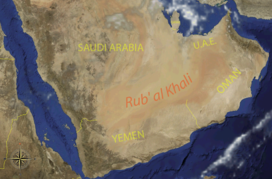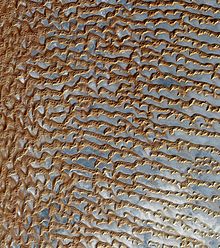Rub' al Khali
| Rub' al Khali | |
|---|---|
| ٱلرُّبْع ٱلْخَالِي | |
 Sand dunes to the east of Liwa Oasis in the Emirate of Abu Dhabi, near the UAE's border with Saudi Arabia | |
 Location of the Empty Quarter in the Arabian Peninsula | |
| Length | 1,000 km (620 mi) |
| Width | 500 km (310 mi) |
| Area | 650,010 km2 (250,970 sq mi) |
| Geography | |
| Countries | |
| Coordinates | 20°N 50°E / 20°N 50°E |
The Rub' al Khali[note 1] (/ˈrʊb æl ˈkɑːli/;[1] Arabic: ٱلرُّبْع ٱلْخَالِي, [ar.rʊbʕ‿al.χaːliː]) or Empty Quarter is a desert[2] encompassing most of the southern third of the Arabian Peninsula. The desert covers some 650,000 km2 (250,000 sq mi) (the area of long. 44°30′−56°30′E, and lat. 16°30′−23°00′N) including parts of Saudi Arabia, Oman, the United Arab Emirates, and Yemen.[3] It is part of the larger Arabian Desert.
Description
[edit]Terrain
[edit]The desert is 1,000 kilometres (620 miles) long, and 500 kilometres (310 miles) wide.[4] Its surface elevation varies from 800 metres (2,600 ft) in the southwest to around sea level in the northeast.[5] Most of the terrain is ergs, with sand dunes up to 250 metres (820 ft) high, interspersed with gravel and gypsum plains.[3][5] The sand is reddish-orange due to the presence of feldspar.[5]
There are also brackish salt flats in some areas, such as the Umm al Samim area on the desert's eastern edge.[5] Ali Al-Naimi reports that the sand dunes do not drift. He goes on to say,
Sand blows off the surface, of course, but the essential shape of the dunes remains intact, probably due to the moisture leaching up into the base of the dunes from the surrounding sabkhas.[6]: 213
Lake beds
[edit]Along the middle length of the desert, there are several raised, hardened areas of calcium carbonate, gypsum, marl, or clay that were once the site of shallow lakes. These lakes existed during periods from 6,000 to 5,000 years ago and 3,000 to 2,000 years ago. The lakes are thought to have formed as a result of "cataclysmic rainfall" similar to present-day monsoon rains and most probably lasted for only a few years. However, lakes in the Mundafen area in the southwest of the Rub' al Khali show evidence of such lakes lasting longer, up to 800 years, from increased runoff from the Tuwaiq Escarpment.[3]
Evidence suggests that the lakes were home to a variety of flora and fauna. Fossil remains indicate the presence of several animal species, such as hippopotamus, water buffalo, and long-horned cattle. The lakes also contained small snails, ostracods, and when conditions were suitable, freshwater clams. Deposits of calcium carbonate and opal phytoliths indicate the presence of plants and algae. There is also evidence of human activity dating from 3,000 to 2,000 years ago, including chipped flint tools, but no actual human remains have been found.[3]
Climate
[edit]The region is classified as "hyper-arid", with annual precipitation generally less than 50 millimetres (2.0 in), and daily mean relative humidity of about 52% in January and 15% in June–July.[4][failed verification]
Biodiversity
[edit]Fauna includes arachnids (e.g. scorpions) and rodents, while plants live throughout the Empty Quarter. As an ecoregion, the Rub' al Khali falls within the Arabian Desert and East Saharo-Arabian xeric shrublands.[5] The Asiatic cheetah, once widespread in Saudi Arabia, is extirpated.[7]
Oil
[edit]The Shaybah oil field was discovered in 1968. South Ghawar, discovered in 1948, is the largest oil field in the world and extends southward into the northernmost parts of the Empty Quarter.[6]: 212, 228
Transport
[edit]A road between Oman and Saudi Arabia,[8][9] through the Empty Quarter, was completed in September 2021.[10] Measuring between 700 and 800 kilometres (430 and 500 miles), it extends from Ibri in Oman to Al-Ahsa in eastern Saudi Arabia. A 160 km (99 miles) stretch of the road is on the Omani side and 580 km (360 miles) on the Saudi side.[8][9] The road also goes through the archaeological sites of Bat, Al-Khutm and Al-Ayn in Oman.[10]
People
[edit]The inhabitants of the Empty Quarter are members of various local tribes: for example, the Al Murrah tribe has the largest area mainly based between Al-Ahsa and Najran. The Banu Yam and Banu Hamdan (in Yemen and the Najran region of southern Saudi Arabia), and the Bani Yas (in the United Arab Emirates). A few road links connect these tribal settlements to the area's water resources and oil production centers.[11]
History
[edit]
Desertification has increased through recent millennia. Before desertification made the caravan trails leading across the Rub' al Khali difficult, the caravans of the frankincense trade crossed now virtually impassable stretches of land, until about 300 AD.[12] It has been suggested that Ubar or Iram, a lost city, region or people,[13] depended on such trade.[14] The archaeological remains of Iram include a fortification/administration building, walls and bases of circular pillars. The traces of camel tracks, unidentifiable on the ground,[15] appear in satellite images.[16]
Expeditions
[edit]The first documented journeys by non-resident explorers were made by British explorers Bertram Thomas and St John Philby in the early 1930s. Between 1946 and 1950, Wilfred Thesiger crossed the area several times and mapped large parts of the Empty Quarter including the mountains of Oman, as described in his 1959 book Arabian Sands.[17][6]

In June 1950, a US Air Force expedition crossed the Rub' al Khali from Dhahran, Saudi Arabia, to central Yemen and back[18] in trucks to collect specimens for the Smithsonian Institution and to test desert survival procedures.[19]
In 1999, Jamie Clarke became the first Westerner to cross the Empty Quarter of Arabia in fifty years. His team of six, guided by three Bedouins, spent 40 days crossing the desert with a caravan of 13 camels.[20]
On 25 February 2006, a scientific excursion organized by the Saudi Geological Survey began to explore the Empty Quarter. The expedition consisted of 89 environmentalists, geologists, and scientists from Saudi Arabia and abroad. Various types of fossilized creatures as well as meteorites were discovered in the desert. The expedition discovered 31 new plant species and plant varieties, as well as 24 species of birds that inhabit the region, which fascinated scientists as to how they have survived under the harsh conditions of the Empty Quarter.[21]
In February 2013, a South African team including Alex Harris, Marco Broccardo, and David Joyce became the first people to cross the border close to Oman of the Empty Quarter unsupported and on foot,[22] in a journey which started in Salalah and lasted 40 days, ending in Dubai. The team only made use of three water stops along the journey and pulled a specially designed cart that housed all the supplies necessary for the entire expedition.[23]
In 2013, British adventurer Alistair Humphreys released his first documentary film, Into the Empty Quarter, documenting his walk through the Empty Quarter desert with Leon McCarron.[24]
In 2013, from 18 February to 28 March, South Korean explorer Young-Ho Nam led a team (Agustin Arroyo Bezanilla, Si-Woo Lee) on a crossing through the Empty Quarter on foot from Salalah, Oman, to Liwa Oasis in the UAE Emirate of Abu Dhabi. The crossing was performed with permission from the governments of Oman and UAE. Dewan Ruler's Representative for Western Region, Emirate of Abu Dhabi recognized it as the world's first on-foot crossing of the Empty Quarter following the border of Oman and ending in UAE.[25]
In 2018, the first all-female walking expedition named "her faces of change" led by Briton Janey McGill who was accompanied by the first Omani women in modern times to walk the Oman Empty Quarter, Baida Al Zadjali and Atheer Al Sabri, set off on 22 December 2018 after receiving formal approval from the government of Oman.[26] The team was supported by two cars for supplies driven by Tariq Al Zadjali (Omani) and Mark Vause-Jones (British) and filmmaker Matthew Milan from the United States. The expedition started from Al Hashman in the Dohafar Governate of Oman crossing through Burkana, Maqshin, and Al Sahma in Al Wusta Region continuing through Abu Al Tabool, Um Al Sameem ending at Ibri fort in the Al Dhahira region of Oman. The total distance walked by the team was 758 km (471 mi) in 28 days, ending the expedition on 18 January 2019.[26]
In 2018, Deidre O'Leary and Kyle Knight crossed the Rub' al Khali from the South (the Saudi-Omani border) to the North (the Saudi-UAE border) on foot.[27] This was the first known crossing within Saudi Arabia from south-north on foot through the highest sand dunes of the Rub Al' Khali. The pair crossed 300 km (190 mi) in nine days 12 hours and 59 minutes.[28]
In 2020, Italian extreme desert explorer Max Calderan completed a Rub' al Khali exploration on foot for the first time ever from west to east. He crossed 1,100 km (680 mi) in 18 days, crossing the widest area of Rub' al Khali.[29]

In 2023, an Austrian-German expedition completed a southwest-to-northeast crossing of the Rub-al-Khali region on the Saudi Arabian side. The route was planned by Austrian Thomas Brandl-Ruttner, leading a team of eight experts in navigation, expedition logistics, and engineering. The team included geo-archaeologist Rudolf Dellmour, who was responsible for scientific documentation. Covering a 1,500-kilometer route through largely unexplored terrain, the team gathered and documented new geological and archaeological findings. Locations that had previously only been studied via satellite imagery were explored on site for the first time.[30]
Gallery
[edit]-
Astronaut photograph highlighting a part of Ar-Rub' al-Khali near its south-eastern margin, in the Wusta Governorate of Oman
-
Sunset in Saudi Arabia

See also
[edit]Notes
[edit]- ^ Other standardized transliterations include: ar-Rubʻ al-Khālī/ar-rubʿ al-ḵālī. The ar- is the assimilated Arabic definite article, al-, which can also be transliterated as al-.
References
[edit]- ^ "Rub' al Khali". Collins English Dictionary.
- ^ Peter Vincent (2008). Saudi Arabia: an environmental overview. Taylor & Francis. p. 141. ISBN 978-0-415-41387-9. Retrieved 22 August 2010.
- ^ a b c d Clark, Arthur (June 1989). Amdt, Robert (ed.). "Lakes of the Rub' al-Khali". Saudi Aramco World. 40 (3): 28–33. ISSN 0003-7567. Retrieved 22 August 2010.
- ^ a b "Rub' al-Khali | Map, Location, Meaning, & Facts | Britannica". www.britannica.com. Retrieved 2024-07-22.
- ^ a b c d e "Arabian Desert and East Sahero-Arabian xeric shrublands". Terrestrial Ecoregions. World Wildlife Fund. Retrieved 22 August 2010.
- ^ a b c Al-Naimi, Ali (2016). Out of the Desert. Great Britain: Portfolio Penguin. p. 211. ISBN 9780241279250.
- ^ Durant, S.; Mitchell, N.; Ipavec, A. & Groom, R. (2015). "Acinonyx jubatus". IUCN Red List of Threatened Species. 2015: e.T219A50649567. doi:10.2305/IUCN.UK.2015-4.RLTS.T219A50649567.en.
- ^ a b Al Shaibany, Saleh (2021-07-06). "Oman-Saudi road to save 16 hours travel time nears completion: New road cuts through the Empty Quarter and will be a lifeline for trade between the two countries". The National. Retrieved 2021-11-09.
- ^ a b Al Amir, Khitam (2021-07-07). "New Saudi-Oman road to cut land travel time by 16 hours: Travel between two countries to get lot easier; road is 800km in length". Dubai, the U.A.E.: Gulf News. Retrieved 2021-11-09.
- ^ a b Al Shaibany, Saleh (2021-09-06). "Oman-Saudi desert road will breathe new life into sleepy villages: 700-km motorway to cut through the Empty Quarter, bringing trade to once-abandoned areas". The National. Retrieved 2021-11-09.
- ^ "Bedouins of the Empty Quarter". Matt Reichel. Retrieved 2024-06-19.
- ^ Van Beek, G. W. (1958). "Frankincense and myrrh in ancient South Arabia". Journal of the American Oriental Society. 78 (3): 141–152. doi:10.2307/595284. JSTOR 595284.
- ^ Interview with Dr J. Zarins, Nova Online, Sept. 1996
- ^ Thomas, B. (1993). "Ubar—the Atlantis of the sands of rub' Al Khali". Journal of the Royal Central Asian Society.
- ^ "Ubar". Madain Project. Retrieved 11 April 2019.
- ^ Fisher, J.; Fisher, B. (1999). "The use of KidSat images in the further pursuit of the frankincense roads to Ubar". IEEE Transactions on Geoscience and Remote Sensing. 37 (4): 1841–1847. Bibcode:1999ITGRS..37.1841F. doi:10.1109/36.774697.
- ^ Morton, Michael Q. (December 2013). "Thesiger and the Oilmen". Journal of the Petroleum History Institute. 14: 125–39.
- ^ "Photographic image" (JPG). Zianet.com. Retrieved 2017-08-10.
- ^ Ted A. Morris. "US Air Force Air Sea Rescue in Saudi Arabia 1950–1951". Zianet.com. Retrieved 2011-04-09.
- ^ Everest to Arabia. Clarke J. Azimuth Inc. 2000
- ^ Saudi Geological Survey. "Desert Studies". Retrieved 2011-10-28.
- ^ "Feature Report- 17 March- Empty Quarter Expedition". City 7 News.
- ^ "empty quarter expedition website". Emptyquarter.co.za. Archived from the original on 9 January 2016. Retrieved 23 December 2015.
- ^ Humphreys, Alastair; McCarron, Leon, Into the Empty Quarter (Documentary, Adventure, Biography), Alastair Humphreys, Leon McCarron, retrieved 2024-06-19
- ^ Kyu Dam Lee. "ExWeb interview with Young-Ho Nam, life is like crossing a desert". ExplorersWeb.
- ^ a b Kothaneth, Lakshmi (2019-01-06). "Omani Women set to conquer Empty Quarter". Oman Observer. Retrieved 2024-06-19.
- ^ Aida Othman. "International Women's Day, Interview with Deidre O'Leary". Outdoor UAE.
- ^ "Kyle Knight, Deirde O'Leary - Crossing the Saudi Empty Quarter (Saudi Arabia) - 2018-01-14". Fastest Known Time. 4 January 2018.
- ^ "Calderan walks over 1,000 km in Rub Al Khali desert". ANSAmed. 2020-02-04. Retrieved 2020-02-27.
- ^ Mayr, Tobias; noe.ORF.at (2024-09-23). "Suche nach Spuren der ersten Menschen". noe.ORF.at (in German). Retrieved 2024-09-24.
External links
[edit]- Rub' al-Khali in Encyclopædia Britannica
- Lost city under the Rub' Al-Khali, Saudi Life (archived)
- Empty Quarter: Exploring Arabia's Sea of Sand, National Geographic (archived)




